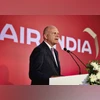Aviation in India is undergoing a phase of consolidation and stability and as it becomes more profitable, it will “certainly” have more than two major airlines in “due course”, Air India Chief Executive Officer and Managing Director Campbell Wilson on Thursday said.
Air India, run by the Tata group, and IndiGo hold more than a 90 per cent share in the domestic passenger market.
The Air India group of airlines, which operates a fleet of about 300 aircraft, is planning to expand to approximately 400 planes by 2027, Wilson stated during his first press conference following Vistara’s merger into Air India on November 11.
Wilson said in 2025 growth would happen primarily on domestic and short-haul international flights because the airline would start taking its widebody planes out of service and start sending them for retrofitting from the first half of next year.
“The number of widebody aircraft that will be available to deploy will shrink a little bit in 2025 … The widebody aircraft fleet will be completely retrofitted by 2027,” he added.
Also Read
He said the plan to retrofit the widebody planes of Air India had been delayed due to global supply-chain issues.
From next month, Vistara’s narrow-body aircraft and Air India’s retrofitted narrow body planes will be put on metro-to-metro routes, he stated.
Retrofitting Air India’s narrow body planes began in September and this process would be through by the middle of next year, he noted.
“On metro-to-metro routes, we have a market share of 55 per cent. On the top 120 routes, which account for 60 per cent of the domestic market, our share is 40 per cent,” Wilson mentioned.
When asked about the “duopoly” in the Indian aviation market, he stated this was just a phase, which other aviation markets of the world had gone through.
“If you look at other geographies around the world over the past few decades, each of them went through a period where there was a lot of fragmentation, all of airlines coming and going, collapsing because it wasn’t profitable. And then they go through a phase of consolidation, and that consolidation brings some stability, it brings some professionalism and profitability, and then ultimately, the fact that there’s a profitable ecosystem attracts new players,” he explained.
Air India, when it was under government control, was not a profitable airline for a long time and it warped the Indian aviation market.
“It had the effect of making the whole ecosystem not very profitable or not profitable at all. And so you had airlines jumping into the market, suffering losses, not being able to weather the cyclical ups and downs, and so you ended up churn and chaos,” he noted.
On being asked when Air India expected to become profitable, he replied: “We don’t give any guidance about profitability. We have internal targets but we don’t discuss them publicly.”
When asked how “Indian” Air India will be as Singapore Airlines now holds 25.1 per cent in it, he replied: “I would say that regardless of how successful we are in attracting nationalities other than Indian, or ethnicities other than Indians to fly, majority are Indian nationals (as passengers) … So the fact that there's a financial stake by someone else, I think, is almost irrelevant.”
Amid human resource concerns after the Vistara merger, Wilson said the enlarged entity offered a “great sort of proposition” for the people and asserted that the airline was a “responsible employer”.
There are certain concerns about seniority, retirement age, and other issues after the Vistara merger.
With inputs from agencies

)